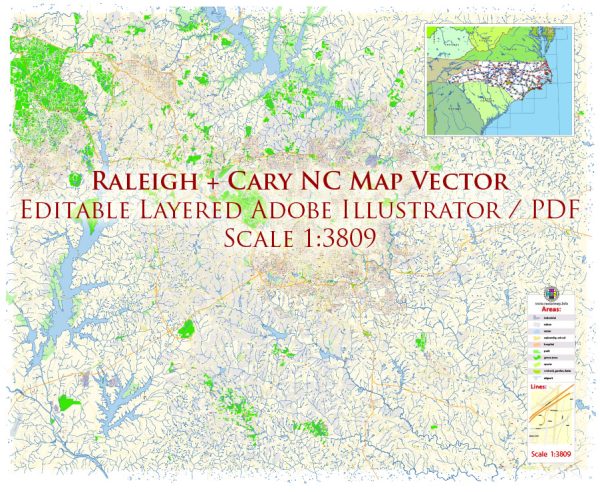Raleigh, Cary, and Durham are cities located in the Research Triangle region of North Carolina, known for their rich history, vibrant culture, and thriving academic and technological communities.
Vectormap.Net provide you with the most accurate and up-to-date vector maps in Adobe Illustrator, PDF and other formats, designed for editing and printing. Please read the vector map descriptions carefully.
Here’s a brief overview of historic places, buildings, streets, and squares in each city:
Raleigh:
1. North Carolina State Capitol:
- Located in downtown Raleigh, the Capitol building is a Greek Revival-style structure that served as the seat of the state’s government from 1840 to 1961. It’s a National Historic Landmark and is open for tours.
2. Mordecai Historic Park:
- This park features the Mordecai House, built in 1785, which is the oldest house in Raleigh on its original foundation. The site includes other historic buildings and offers insights into the city’s early history.
3. City Market:
- Established in 1914, City Market is a historic market area with cobblestone streets. It houses shops, restaurants, and galleries, offering a blend of history and modern amenities.
4. Dorton Arena:
- Located at the North Carolina State Fairgrounds, Dorton Arena is an iconic example of mid-century modern architecture. It was completed in 1952 and is known for its unique design.
Cary:
1. Page-Walker Arts & History Center:
- The Page-Walker Hotel, built in 1868, is now the Page-Walker Arts & History Center. It provides a glimpse into Cary’s past and hosts cultural events and exhibits.
2. Cary Historic District:
- The district features various Victorian-style homes, churches, and historic buildings, showcasing the town’s architectural history.
3. Cary Arts Center:
- Originally built as Cary High School in 1938, the Cary Arts Center now serves as a hub for arts and cultural activities. The building has undergone renovations to preserve its historic charm.
Durham:
1. Tobacco Campus (American Tobacco Historic District):
- Once the heart of the tobacco industry, this district has been transformed into a vibrant space with offices, restaurants, and entertainment venues. The historic tobacco warehouses are preserved and repurposed.
2. Duke University Chapel:
- Located on the campus of Duke University, the Duke Chapel is a stunning example of Gothic architecture. It was completed in 1935 and is a focal point of the university.
3. Hayti Heritage Center:
- The Hayti Heritage Center is dedicated to preserving the history of the African American community in Durham. It is housed in the historic St. Joseph’s AME Church, which dates back to the 19th century.
4. Durham Bulls Athletic Park:
- While not historic in the traditional sense, the Durham Bulls Athletic Park is the home of the Durham Bulls minor league baseball team. The park is located in the historic tobacco district, adding a modern touch to the area.
These cities collectively offer a diverse range of historical sites that reflect the growth and development of the region over the years. Whether it’s the state capitol, historic districts, or repurposed tobacco warehouses, each place contributes to the unique identity of the Triangle area in North Carolina.


 Author: Kirill Shrayber, Ph.D.
Author: Kirill Shrayber, Ph.D.